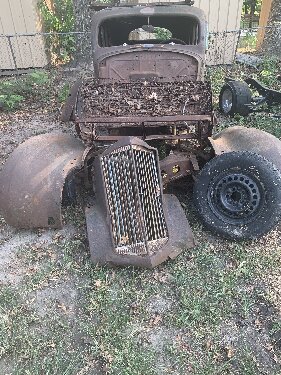|
Re: '39 Packard 110 Transmission Fluid (& Rear Dif Fluid)
|
||||
|---|---|---|---|---|
|
Webmaster
|
I just refilled my diff with 85W-140 EP. It replaced the smelly burned whale oil that has been in there for god knows how long.
Posted on: 2010/7/6 16:30
|
|||
|
-BigKev
1954 Packard Clipper Deluxe Touring Sedan -> Registry | Project Blog 1937 Packard 115-C Convertible Coupe -> Registry | Project Blog |
||||
|
||||
|
Re: '39 Packard 110 Transmission Fluid (& Rear Dif Fluid)
|
||||
|---|---|---|---|---|
|
Home away from home
|
Some additional info on early EP lubricants:
The primary additive that was added to the early gear oils to give them the EP (extreme pressure) rating was sulfur. Because of the tooth geometry of the new hypoid gears used in the differentials the existing gear oils would not provide protection against the higher pressure gear tooth load that was present in the hypoid differential. At the time sulfur or sulfur based compounds were used to give the lubricant a EP rating. One problem with sulfur or sulfur based compounds is when moisture is added the compounds tend to form sulfuric acid. The acid that could be formed using a sulfur based oil would attack the lighted metals, brass, bronze, and aluminum. If you've taken apart an old transmission or differential that used sulfur based oils you'll notice two things, a very distinct smell and a thick dark gooey sludge that covers everything. This smell and sludge is the remnants of the sulfur in the oil. As stated in previous posts a modern GL-5 or GL-5 gear oil that meets MIL-L-2105 contains corrosion and EP additives that makes them suitable for hypoid and spiral bevel gears. I've had good luck with a multigrade 85W-140W in a '32, 4 spd. syncro transmission, spiral bevel differential, and worm and sector steering box. One trick that will help, machine the transmission and differential plug to accept a neodymium magnet that is nickle plated. The strong magnet will capture any fine particles that wear from the gears over time. The same trick works equally well on crankcase plugs. If you use a neodymium magnet just make sure it's nickle plated to prevent corrosion. A groove machined into the bore of either of the plugs will accept a snap ring to keep the magnet in place. Regards, Dave
Posted on: 2010/7/11 15:13
|
|||
|
||||
|
Re: '39 Packard 110 Transmission Fluid (& Rear Dif Fluid)
|
||||
|---|---|---|---|---|
|
Forum Ambassador

|
Lucky guy, the 4-speed synchro trans offered only in 1932 is indeed very rare, only available for a very short time as they tooled up for the new 3-speed synchro. In fact in 45+ years of dabbling and talking with Packard owners I've only ever run across one other.
Posted on: 2010/7/11 15:40
|
|||
|
||||
|
Re: '39 Packard 110 Transmission Fluid (& Rear Dif Fluid)
|
||||
|---|---|---|---|---|
|
Home away from home
|
Owen,
I had it for a while before I even realized there was a lower 1st gear. Because you have to pull the gear shift lever to the left and down against a spring and I'm sure there were a few that never realized this extra gear. I never use the low low, at a slow idle in low low I can almost walk around the car. Couple this with the high low end torque of the engine and it's no wonder these cars were turned into service station wreckers. One comment on the '32 transmission, it has a very unusual sound. I've met people at shows that drove these cars when they were new and they told me it was called a "singing transmission". The transmission produces a sound in 1st and second that is hard to describe. Almost a musical note, not a gear whine. Regards, Dave
Posted on: 2010/7/11 15:50
|
|||
|
||||









